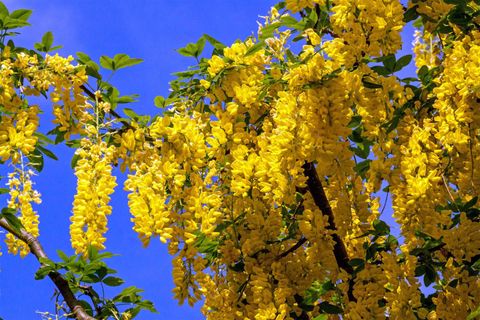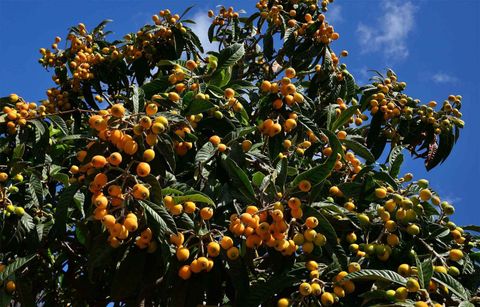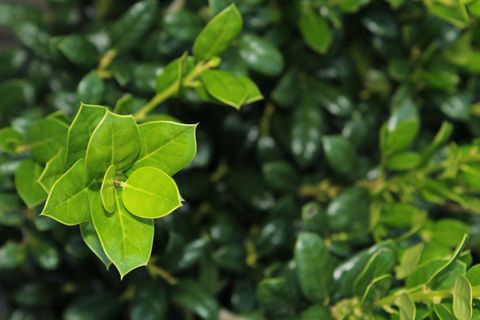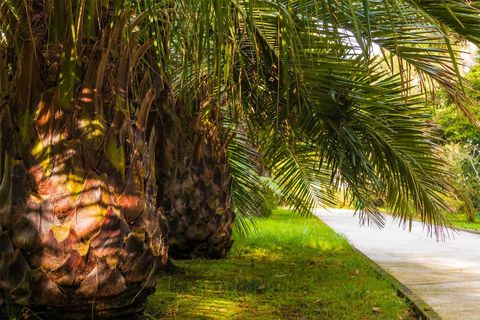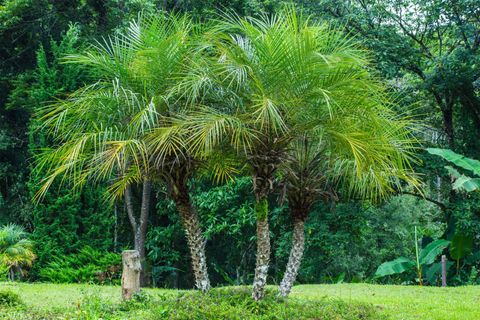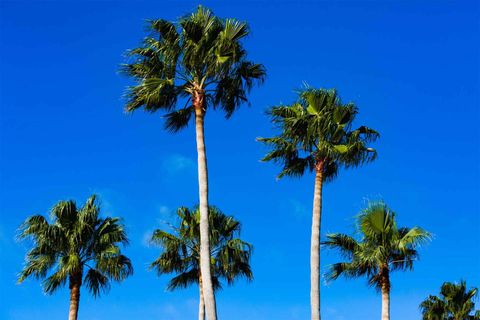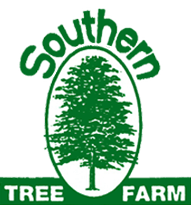Jacksonville's Local 36-Acre Tree Nursery
Flowering Trees
Flowering Trees add a picturesque look to your landscape. Not only do we grow lovely flowering trees on our farm, but we also offer landscaping and transplanting services. Here you will find descriptions of flowering trees, growing conditions, tree height, and more.
Golden Rain
The mature golden rain tree reaches a height of 20 to 40 feet, with a spread of between 20 and 35 feet. They are rapidly growing trees, thus providing fast-growing shade to gardens. The golden rain tree grows best in full to partial sun and well-drained, moist, rich, and deep soils. But the golden rain tree does have a high tolerance for pollution and a remarkable tolerance for difficult growing conditions, handling drought, wind, heat, and is able to adapt to poor and compact soils and soils with various pH levels.
Golden rain trees and add floral color in late summer when other popular landscape trees are green. Golden rain trees shed their leaves annually during the wintertime.
There are three noteworthy species of golden rain trees, which are native to eastern Asia; the bougainvillea golden rain tree, which notoriously produces thousands of seeds from its branches each fall, the panicle golden rain tree which is the most cold-hardy of the trio and the Chinese rain tree or flame gold, which is the subtropical species and yields bumper crops of seeds that germinate readily.
The leaves of the golden rain tree are pinnate, meaning that they look like a feather in appearance. Their many dark green leaflets are serrated and irregular. The bougainvillea golden rain tree’s leaves are twice-pinnate, meaning its larger leaves have second tiers of branches that bear leaflets.
In late summer, these trees produce millions of tiny yellow flowers on wispy clusters on branch tips to make the tree look like a powdery, airy golden “rain” or mass of lace. After the flowers appear, papery seed pods form that contain small black seeds. Their color at first is pale green, then they ripen to shades of deep salmon-pink or tan and brown. These seedpods, which look like three-sided lanterns, continue into winter and at times look like flowers themselves, adding color and texture to the tree’s canopy when viewed from a distance.
The prolific seed production of golden rain trees potentially causes weediness in landscapes, as seedlings sprout all over. Their weed status can become invasive and need to be monitored to get rid of tree seedlings.
Ligustrum
Ligustrum can grow up to 40 feet high depending on what kind of ligustrum it is. There are about 50 species of the ligustrum and most are native to Asia, Europe, Australia, and Malaysia. Ligustrum is a glossy privet tree, meaning it is an evergreen shrub or small tree. It has glossy pointed leaves that typically fold upward like a "V". Small white flowers, which emit an unpleasant odor, appear in the late spring or summer, it then produces small blue or purple berries later in the season. The ligustrum can be used as hedges, shrubbery, foundation plantings, accent shrubs, and stand-alone trees as single ornamentals. Ligustrum is often used as a thick privacy screen.
It is a hardy plant but is generally limited to warmer, southern climates, and along with coastal areas. It is easy to grow to the point of becoming an invasive weed in some areas. Ligustrum plants need only a moderate amount of water. For this reason, they are commonly planted along roadsides and in parking lots where little maintenance is required. The ligustrum can survive in most soil conditions. It is not limited in its growth by its location in a yard, growing well in both shady and sunny parts of the landscape. Ligustrum also grows well in containers.
The most common forms of ligustrum are:
- Ligustrum japonicum, known as Japanese privet, also called wax privet is either a tree or large shrub that generally grows to a height of 6 to 18 feet. It is commonly sheared and pruned into hedge form Japanese privet has thick, glossy leaves up to 4 inches long and white flowers that look pretty but do not smell good.
- Ligustrum lucidum, also called the glossy privet, is an evergreen shrub or small tree growing to a height of about 30 feet. As indicated by its common name, the leaves are a shiny dark green.
- Ligustrum sinense, also known as Chinese privet, is a common semi-evergreen large shrub or small tree that usually grows to heights of 6 to 21 feet and is characterized by hairy shoots. The plant is often used as a bonsai tree. It is considered to be an invasive weed in moist areas of the southeastern United States. It should not be used as a landscape plant in Florida.
- Vicary Golden Privet can grow up to 12 feet tall and produces golden leaves. This deciduous ligustrum grows better as a tree than pruned as a shrub and makes a lovely ornamental tree. This tree tolerates drought and its small, white flowers and blackberries attract birds and butterflies.
Loquat Trees
Loquat Trees are also called the Japanese medlar, usually grow to a height of around 10 feet, but can grow to as high as 20 to 30 feet. The leaves of a Loquat tree are usually shaped like the head of a lance or spear and are 5-12 inches in length with a width of three to four inches. The upper surface of the leaves is generally glossy and dark green, while the underneath is rusty, hairy, or whitish and is stiff and thick, with oblique veins. New leaves may be tinged with red at times. They grow best in full sunshine and the soil should be neutral to acidic, as loquats do not grow well in alkaline soil. The soil should be fertile, loamy, and well-drained. These trees are best grown in a mild-temperate to subtropical climate. Loquats are usually planted for ornamental purposes.
In early winter or late fall, the tree bears sweet fragrant flowers, which are small and white in color. Before the flowers bloom, they show an unusual rusty-wooly texture. Once pollinated, the flowers form loquat fruits. The fruit size can be from one to two inches long. They grow in clusters and are either pear-shaped, oval, or rounded. The skin is usually orange or yellow in color, or may at times be red-blushed in color. To produce fruits of the highest quality, the flower clusters may be bagged so as to protect them from being damaged by birds and sunburn. The seed of the loquat fruit is poisonous if ingested.
Magnolia Trees
Magnolias are able to grow as high 60 to 80 feet high and spread out from 30 to 50 feet wide. They are large evergreen trees known for their beautiful large, fragrant flowers, large leaves, fruit, and plant forms. These trees are unique in that magnolia flowers don’t produce true nectar, but yield pollen in large quantities. The pollen, which is rich in protein, is a food supply for beetles that typically pollinate the tree’s flowers.
There are more than 80 types of magnolia trees in the world and are resistant to most diseases and insects and are easy to grow. Magnolias do not tolerate cold temperatures. The most popular magnolia tree varieties are southern magnolia, cucumber magnolia, Sauder magnolia, star magnolia, sweet bay magnolia, magnolia grandiflora, and Asian magnolia-each one being unique and attention-grabbing.
Holly Trees
Burfordi Trees
Burfordi can grow to 15 to 25 feet high and have a spread of 15 to 25 feet. Burdfordi can be used as a dense evergreen shrub or small tree. It’s leaves are a dark glossy green. Usually, only one leaf spine is present and is at the tip of the leaf. They produce fragrant white flowers in the spring and large bright red long-lasting berries during the fall.
Although typically pruned for formal hedges, the large form and gracefully drooping branches of burfordi holly make it ideal for unpruned natural plantings or as a specimen for spacious areas and large buildings. It is a very popular landscape holly.
Burfordi grows best in rich, well-drained, slightly acid soil and in full sun or part shade. Although if planted in shady locations, the flowering and subsequent fruiting is reduced. Burford Holly is drought-tolerant and easy to grow once established. It is well suited for low-maintenance landscapes that receive little or no irrigation or fertilizer after trees are established.
East Palatka Holly
East Palatka Holly grows to 30 to 45 feet tall and has a moderately tight pyramid shape-their spread being from 10 to 15 feet. The leaves are rounded, broad, dull green, and have one spine at the tip. Their white flowers bloom in spring. East Palatka Holly is a female Holly plant, so it is heavily laden with bright red berries in fall and winter, especially toward the top of the tree. East Palatka Holly grows quickly in full sun or partial shade on moist, acid soils.
They are a popular landscape tree as they are very good as an ornamental tree and make a durable street tree throughout its range and are quite drought-tolerant once it becomes well-established. The natural shape of the tree is rarely seen but is a graceful pyramid of drooping branches growing from a strong central trunk, laden with bright red berries that remain on the trees until eaten by birds.
Oak Trees
Laurel Oak Trees
The laurel oak is fast-growing, tall, and full. This large tree can reach heights of 65′ to 100′. Its crown is full and rounded with a mass of 3 to 4 inch long leaves. The leaves of the laurel oak are simple, arranged alternately, and may stay on the tree until gradually falling off in early spring. These elliptical shaped leaves usually have smooth, shiny bright green upper surfaces. The surface underneath is smooth and light green. The greatest bloom is usually observed in the early spring, with fruit and seed production starting in the summer and continuing until fall. Leaves that turn yellow in the fall may remain on the tree throughout the winter months and then drop in the spring.
The trunk is tall and straight and has gray/brown bark that is smooth on young trees and then becomes increasingly ridged on more mature trees. This tree has a short lifespan.
The acorns are about ½” long and occur solitary and occasionally paired. The reddish-brown cap covers ¼ of the light brownish acorn. Acorns mature in two growing seasons. Laurel oak produces large crops of acorns regularly beginning when the trees are about 15 years old. It is an important wildlife food resource for whitetail deer, raccoons, squirrels, turkeys, ducks, quail, birds, and rodents.
Laurel oaks can grow in several habitats, ranging from moist, well-drained sandy soils in woodlands and hammocks near streams and swamps to better-drained upland sites. The laurel oak is generally described as a perennial tree and is native to the U.S. Its most active growth period is in the spring and summer. It has a low tolerance to drought and restricted water conditions and is tolerant of shade.
The laurel oak is commonly used as an ornamental landscape tree suitable for large spaces. It is also used for firewood, as well as pulpwood for making paper. Some large trees are sawn into large timbers for industrial uses.
Live Oak Trees
Live oaks grow to around 65 to 85 feet tall. The canopy of the tree often spreads wider than their height, reaching widths of up to 120 – 150 feet. They are the broadest spreading of the oak trees producing an abundance of shade. The base of the trunk is buttressed and flared. Because of its large spread, it is a very popular shade tree.
The leaves are simple and alternately arranged. The leaves stay on the tree through winter until they gradually fall as new leaves emerge in the spring. The leaves are 2″ to 5″ long by ½” to 2 ½” wide. The narrowly to broadly elliptical shaped leaves are usually stiff and leathery. The upper surface of the leaves is shiny and dark green and dull grayish-green underneath. The leaf base is tapering and the tip is shortly pointed to rounded. The bark is dark brown to reddish-brown, thick with shallow furrows, and roughly ridged and eventually becomes blocky with age.
The wood of the live oak is yellowish-brown, very hard and strong, and was used years ago for shipbuilding, structural beams, posts, and in places that require strength and durability. Today, while the wood is still used for furniture and fuel, it is predominantly used as a shade and ornamental tree. It is often used as a centerpiece within the landscape. When planting live oak, it should be restricted to large yards or parks where the spreading form can be accommodated. Live oak is one of the heaviest native hardwoods, weighing 55 pounds per cubic foot when air dry. This weight or density makes live oak a good fuel wood although it can be very difficult to split.
These oak trees remain green and “alive” throughout the winter when other oak trees are dormant and leafless, thus the name and reason they are called “Live Oaks”.
Live Oaks can adapt to almost any soil, grow rapidly when young, and often live to be centuries old. It prefers moist, acid soils made up of sand, clay, or loam. It normally grows in low sandy soils near the coast by oceans (they can resist salt spray) but also occurs in moisture-rich woods, forests, commonly scattered in pastures, flatwoods, borders of salt marshes, hammocks and along stream banks. They can grow in front of buildings, parking lots, roadsides, gardens, and backyards. Because the live oak tends to have shallow roots, they should be planted well away from walkways, driveways, and buildings as the roots and branches might become a threat to the structure. The tree will grow in partial shade but prefers full sun.
Live oaks often support many types of epiphytic plants, including Spanish moss and mistletoe. Because the Spanish moss hangs in weeping garlands, it gives the live oak trees a striking appearance.
They have separate male and female reproductive units on the same plant- producing male flowers called catkins that bloom in hanging clusters. The female flowers appear singly or in clusters of one to five where the leaves join the twigs. They produce flowers every spring from March through May and the acorns mature in September and fall off by December. Live oak acorns have a light brown cap that covers ¼ of the mostly dark nut, are long, dark brown to black, and tapered. They are sweet and very popular with turkeys, ducks quail, deer, squirrels, and other animals. If the acorns fall on the moist, warm ground, they will germinate soon after falling. Live Oak trees start producing acorns when they are around 20 years old.
Palm Trees
Canary Island Palm
The canary island palm is a large tree that reaches 60-70 feet tall and 25 feet wide. The trunk can reach a diameter of four feet and is covered with an attractive, diamond-shaped pattern from old leaf scars. Young Canary Island Palms resemble giant pineapples. It has a fat trunk with a predominant bulge at the top with a large crown of 8-15 foot long leaves. The leaves are stiff and green. It produces white flowers that bloom in spring which are inconspicuous and not showy, The stalks of inconspicuous flowers are replaced with clusters of one-inch-diameter, orange-yellow, date-like, ornamental fruits which ripen in early summer. The ‘dates’, are oblong and about 1.5 inches in length and consist of a large pointed seed surrounded by sweet sugary flesh. Male and female flowers grow on separate plants. Only female plants produce dates and only if a male tree is nearby.
Canary Island Date Palm should be grown in full sun on fertile, moist soil for best growth and require pruning to remove old fronds.
Queen Palm
The queen palm can reach a maximum height of about 50 feet. It has a smooth straight grey trunk ringed with evenly spaced leaf scars and crowned by a beautiful head of glossy, bright green, soft, pinnate leaves forming a graceful, drooping canopy. The fronds are dark green and have double rows of leaflets. This palm is noted for its spectacular clusters of flowers and fruits. The flower colors can be white/cream/gray and showy. In early winter, green fruit clusters appear. The spherical-shaped fruit eventually turns bright orange, hanging in clusters up to six feet in length. In each fruit, there is a single hard seed with three spots. The ornamental, bright orange dates are produced in hanging clusters and ripen during the winter months. Queen Palms grow best in full sun and is most suited for acidic, well-drained soils.
Robilini Palm
The robilini palm also known as the pygmy date palm, can grow from 6 to 12 feet tall. It is native to Laos and Southeast Asia. As it matures, it develops beautiful marks or scars on its trunk. These marks and scars naturally occur from the palm tree losing the old fronds from the trunk. These palms are known for their beautiful fronds and have sharp needle-like spikes. When small, the Robellini Palm Tree usually grows in pairs or triplets, and this is due to its ability to develop sucklings. Sucklings develop from the root base of the palm and emerge as a full palm tree. The Robellini palm has been a favorite for indoor potting for decades and has been a staple for outdoor landscaping. This small palm tree thrives in partial shade to full sun.
Sago Palms
Sago Palm trees are one of the most primitive living seed plants and are very unusual. Sago Palms are a very popular landscape item and is the most common cycad used in the landscape. Most people don’t realize that it is not a palm at all. Rather this plant is a Cycad, a totally different type of plant. It has an erect rugged trunk, that is typically about one to two feet in diameter, sometimes wider and can grow into very old specimens with twenty feet of trunk. Sago Palms are topped with stiff feather-like leaves growing in a circular pattern. The leaves are a dark olive green and about three to four feet long when the plants are of reproductive age. They can be longer if not grown in full sun. New leaves emerge all at once in a circular pattern and are very tender until they begin to harden several weeks later. Trunks can branch multiple times, thus producing multiple heads of leaves. Sago Palm plants adapt to a wide range of temperatures from 15 to 110 degrees F (-11 to 42 degrees C), Sagos accepts full sun or bright interior light, thrive with proper care and maintenance, and tolerates neglect.
Washatonia Palm
Washatonia Palm has a tall, slender trunk and is topped with a crown of large fan-shaped evergreen fronds. The Washingtonia Palm Tree grows rapidly and can soar to over 100 ft. It is a popular landscape plant in Florida, California, and Arizona and in areas where it is hardy throughout the world. It is a striking sight when planted at equal intervals along a boulevard or in groups against high rise buildings. This palm should only be used in large open areas – it is NOT a good palm for residences with small yards. The gray trunk is ringed with closely set leaf scars although usually, at least part of the trunk remains covered with dead leaves that hang in a thatch. The solitary trunk, about 10-12 inches in diameter, bulges at the ground and becomes slender as it approaches a crown of large palmate leaves with gracefully drooping leaflet tips. These are rich glossy green and grow to about 5 ft long and 4 ft wide. They are borne on 3 ft orange leaf stems that are edged with vicious sawtooth spines.
As the leaves die, they fall against the trunk to create a “hula skirt” effect for which this palm is famous. Washington palms in Florida usually do not reach maximum height as they tend to get their crowns cut off by lightning when they begin to tower over neighboring trees.
In early summer large, light beige, branched inflorescences extend past the leaves growing 7-10 ft long. These hold clusters of small whitish flowers that mature into 1/2 in blackberries that are easy (for a palm) to germinate.
Washington palm prefers moderately rich well-drained soil but can survive on poor soils, even sand. It does best in bright sunny conditions but Washington palm will tolerate some shade.
Windmill Palm
The Windmill Palm can reach 40 feet in height. Its leaves are arranged into a symmetrical crown that is about 8 to feet wide. The trunks are usually covered with a loose mat of coarse gray or brown fiber. and the three-foot-wide, fan-shaped fronds extend from 1.5-foot-long, rough-edged petioles. Windmill Palms have a rather slender single stem that is 8 to 10 inches in diameter and is typically a bit narrower at the base than at the top. Windmill Palm should be grown in shade or partial shade on fertile soil, but it is also tolerant of full sun on well-drained soils.
Shade Trees
Bald Cypress Trees
The bald cypress can grow from 50 to 70 feet high and provides a spread of around 30 feet. It is commonly used in landscaping. A tall deciduous tree that produces cones, the bald cypress belongs to the non-flowering group known botanically as gymnosperms. It has a pyramidal shape or plump column-like stature. The bald cypress tree has a straight trunk with horizontal branches extending from it. The bark of this tree is reddish-brown in color. The leaves of the bald cypress tree are light green in the spring and gradually darken to dark green in the summer. In the fall, the leaves turn brown. The trunk and root system of this tree is such that it rarely is blown down by strong winds or damaged in hurricanes.
The bald cypress tree grows naturally in the American Atlantic Coastal Plain from Delaware to southern Florida and westward along the Gulf Coast and lower Mississippi River valley to eastern Texas. This water-loving tree grows in moist woodland areas and along the edges of swamps.
Bald cypress trees should be grown in full sun to partial shade, ranging from four to over 10 hours of direct sunlight daily. The bald cypress tree grows well in a variety of soils, including wet soils, dry soils, chlorotic soils, and soils with a high pH. This tree is tolerant of heat, humidity, and winter cold as well as drier upland soils that are far from the water’s edge.
Sycamore Trees
Sycamore trees grow to be 70 to 100 feet tall with a spread between 60 and 80 feet. They are typically broad, round and some can have trunk diameters of more than 10 feet. Its massive spread is why they make great shade trees. It has a notable bark that looks mottled or jigsaw-like in appearance with patches of tan, cream, gray, and off-white shades.
The leaves of a sycamore tree are light green that turns golden in color in the fall. The leaves of the sycamore tree are very large with the common size being 4 to 8 inches across. The leaves have three to five shallow lobes, making them resemble enlarged maple leaves and toothed along the edges. The leaves are green on top, with a duller shade of green below. During summer, the color is bright green with a display of yellow foliage in the fall. The flowers are red, tiny and inconspicuous, appearing in the spring. The fruit is a hard, green, lumpy, round ball about 1 inch in diameter on the end of a 2- to the 3-inch stem.
Sycamore trees are often used to line streets and thoroughfares in urban areas. The tree is also used in residential settings and parks for shade and as a landscape plant. They are also valuable for timber.
The sycamore tree favors a climate range between 40 and 70 degrees Fahrenheit with extremes of -30 and 105 degrees Fahrenheit. The sycamore can grow in a variety of soils but prefers moist ground, especially in the northernmost portions of its native geographic range. They will often grow along rivers and streams. It is not very tolerant of flooding during the growing season. The sycamore is also fairly drought tolerant and can handle salt well, making it a good choice for urban environments. Sycamore trees prefer full sun.
